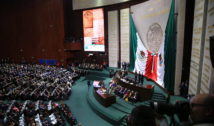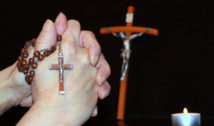
Gallup poll: U.S witnesses lowest levels of satisfaction with religion since 2001
- By Alison Lesley --
- 18 Feb 2015 --

A slight majority of Americans are satisfied with the influence of organized religion in the U.S., according to a Gallup poll.
The level of satisfaction with religion in the United States has dipped quite considerably over the years, presently settling at 53% as a Gallup poll suggests, as against high points of 69% to 58% between 2002 – 2004.
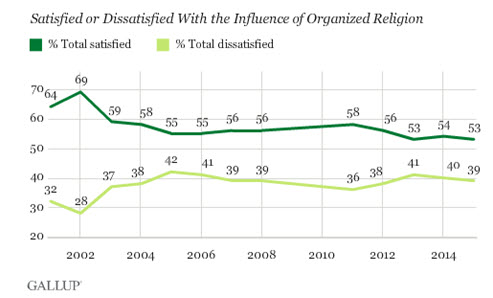
In the Gallup annual Mood of the Nation Survey which is conducted yearly, with “Satisfaction with Organized” religion being tracked alongside 26 other aspects of American life, back in 2001 – exactly 8 months before the 9/11 attacks – 64% of Americans indicated satisfaction with the influence of religion. The number quickly shot up to 69% a year later, before finding some sort of equilibrium slightly below the 60 percent level in the years after.
Although the satisfaction with organized religion, as the Gallup poll tells us, has taken a stable trend since 2005, slightly lower levels have been recorded in the past three years.
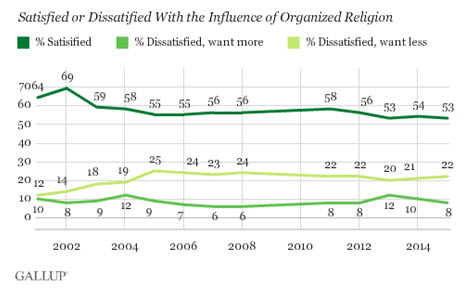
Quite interestingly, almost all the Americans dissatisfied with the influence of religion called for reduction in the influence of organized religion in the U.S. The number equates 22% of the dissatisfied group. 8% of the group, on the flipside, said they will like to see organized religion in the U.S have more influence.
Over the years, the league of Americans who are dissatisfied and want to see religion exercise lesser influence have consistently been bigger than the group who are dissatisfied and want it to have more influence. The gap between these two groups has since grown bigger by the years, as the overall satisfaction with organized religion dropped back in 2005. There has been little meaningful change in these trend lines in more recent years.
The response to the question of reduction or increase in influence of religion was seen to vary in the population according to religious service attendance levels. While satisfaction is at 61% among those who attend religious services weekly, it stands at 47% among those who seldom attend services or not at all.
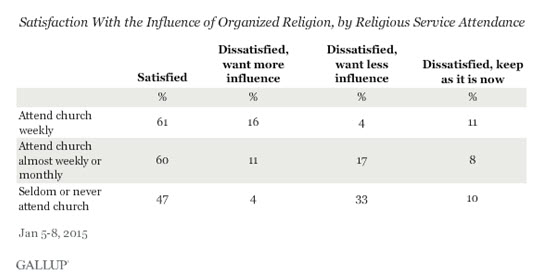
Expectedly, a higher proportion of those who occasionally attend religious service and who are dissatisfied, belong to the group seeking lower influence of organized religion. On the flipside, those who attend church weekly and are dissatisfied clamor for an upside in the influence of religion.
On the larger outlook,those who have zero religious service attendance or affiliation are twice as likely to be dissatisfied and to want to see religion have less influence than weekly churchgoers are to be dissatisfied because they want it to have more influence, 33% vs. 16%, as stated by Gallup.
Finally, the available data from the poll suggests that 77% of the most religious Americans are either “ok” with the current influence of organized religion, or are dissatisfied and would like to see increased influence. The percentage of Americans who are in this group drops among the least religious Americans, but still is a majority, at 51%.
Gallup Poll: 22% of Americans Are Dissatisfied with Organized Religion and Wish It Had Less Influence http://t.co/YStpcaW07n
— Hemant Mehta (@hemantmehta) February 12, 2015
The interpretation and implication of this data is not far-fetched. It emboldens the fact that the satisfaction with organized religion has considerably fallen over the decade in the U.S. This also, of course, comes with changes in the measure of other aspects of religion. Increase in the percentage of Americans who say they have no formal religious identity, comes to mind.
The Gallup data in very simple terms suggests that the drop in the satisfaction with organized religion in the U.S somewhat reflects a general shift in religious trends over the years.
Would these disturbing numbers continue to grow in the years to come? Just as it is with every other statistical projection, no one can tell accurately.
For more information on this Gallup poll and how it works, you can visit the Gallup website here.














